A War Exposed
(The Civil War)
The Civil War was the first American war to be well documented through photography. Photographers were quick to seize the commercial, historical, and artistic opportunities presented by the war. Mathew Brady invested heavily in equipment to send teams of photographers to army camps and battlefields. The wet-plate collodion process, already complex and time-consuming in a studio setting, proved to be even more difficult in the field, but still thousands of photographs were taken.
In his studio portraits, Brady celebrated America’s military and political heroes. On the battlefield, he and his assistants, including Alexander Gardner, Timothy O’Sullivan, and George Barnard, witnessed and documented the darker realities of war.
Public exhibitions of the photographs in the galleries of Brady and his competitors brought home the war’s horrors in an unprecedented way. Gardner recognized the power of his images when he wrote about one of them, “It shows the blank horror and reality of war, in opposition to its pageantry, here are the dreadful details! Let them aid in preventing such another calamity falling upon the nation.”
Millions of soldiers served in this bloodiest conflict in American history. More than 600,000 men died, more than in all other American wars combined. A staggering number of these soldiers had their photographs taken, many sitting before the lens for the first time. Some posed in uniform for studio portraits before leaving home. Hundreds of thousands had their pictures taken in the field by thousands of small-town and itinerant photographers who followed the armies. Families back home treasured these portraits, many of which proved to be the last image of a soldier lost in the war.
 |
Mathew Brady. "Brady's Incidents of the War,” 1861-1864. [zoom] Albumen print, 14 1/2 x 9 in. Brady’s photographs profoundly shaped public perceptions of the war. They were the basis for hundreds of engravings printed in the mass-marketed Harper’s Weekly, and the public thronged to exhibitions in Brady’s galleries. In 1862 the New York Times wrote that “Mr. Brady has done something to bring home to us the terrible reality and earnestness of war. If he has not brought bodies and laid them in our dooryards and along the streets, he has done something very like it.” |
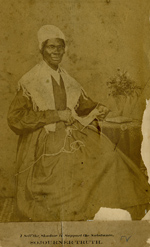 |
Unidentified. Sojourner Truth. 1864. [zoom] Albumen print, cabinet card mount, reproduction of an 1864 carte de visite Abolitionist and women’s-rights leader Sojourner Truth (1799-1883) worked tirelessly for the poor and the disenfranchised in mid 19th century America. Born into slavery, Truth traveled and lectured about the inhumanity of slavery and the rights of African-Americans and women. Famously, she asked, “And ain't I a woman?” To heighten awareness of her work and to raise funds to support it, Truth sold copies of this photograph with the caption, “I sell the shadow to support the substance.” |
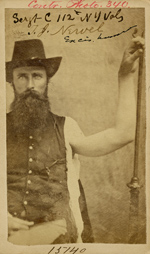 |
Unidentified. Civil War Medical Cartes de Visite, ca. 1860. [zoom] Albumen, cartes de visite mount Additional images:  
The Union Army used photography extensively to document wounds and treatments. These images show a severe dislocation and a gunshot wound. The photograph of the gunshot wound bears detailed medical annotations. Private Cyrus Straus of Illinois was shot at Atlanta on August 6, 1864 and was admitted to hospital in Nashville on September 21. On October 1 part of the bone was removed. Gangrene set in on October 4 but was arrested with the use of bromine. |
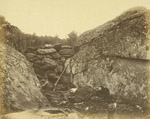 |
Alexander Gardner. “Home of a Rebel Sharpshooter,” 1863. [zoom] Albumen print, 7 x 9 in. Gardner's Photographic Sketchbook of the Civil War. Volume 1. Philip & Solomons. Publishers, Washington DC. 1865. This poignant image of a fallen Confederate soldier was published in Gardner’s Photographic Sketch Book of the War. One of the most famous series of Civil War photographs, the collection of 100 prints helped define a new view of the realities of war. A century after this photograph was taken, scholars determined that Gardner and his assistant had moved the body of the fallen soldier, using the corpse and a prop gun for several different images including this dramatic view. |
 |
Brady’s Gallery (attributed to). Clara Barton with Civil War Soldiers, 1861-1865. [zoom] Albumen print, 5 1/4 x 7 7/8 in. Known as the “Angel of the Battlefield,” Clara Barton (1821-1912) was a leading figure in the distribution of medical supplies, food, and clothing to wounded soldiers. She was present at a number of the war’s grimmest battlefields. After the war she founded the American Red Cross and became a key figure in the woman’s suffrage and civil rights movements. |
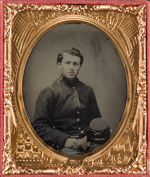 |
Unidentified. Union Soldier Honored for His Service, 1861-1865. [zoom] Hand-tinted ambrotype, sixth plate This ambrotype portrait of a young soldier was probably taken shortly before his deployment. The patriotic brass mat features two flags, a cannon, a gunship, and the words “Constitution and Union, July 4, 1776.” Families treasured photographs of loved ones who went off to war, many never to return. |
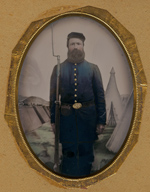 |
Unidentified. Civil War Soldier, 1861-1865. [zoom] Hand-colored tintype, full plate This tintype portrait has a hand-painted background, seemingly transforming the portrait from a studio to a battlefield setting. Inexpensive, durable, and easily mailed home, tintypes were immensely popular with soldiers and their families. |
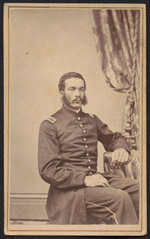 |
Unidentified. 2nd Lieut. William H. Dupree, 1865. [zoom] Albumen print, carte de visite mount Dupree was one of the three fully commissioned black officers of the renowned 55th Massachusetts Volunteer Infantry. The chaplain of the famous regiment called Dupree and his two fellow black officers, “Three as worthy men as ever carried a gun.” They were promoted from the ranks in 1864 but the army refused to muster them in as officers until the end of the war. |
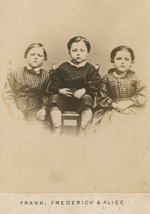 |
Wenderoth, Taylor & Brown. “The Children of the Battlefield,” 1864. [zoom] Albumen print, carte de visite mount Additional images: 
The text on the verso notes that this carte de visite is a copy of an ambrotype found in the hands of Sgt. Humiston of the 154th New York Volunteers, found dead on the Gettysburg battlefield. A Philadelphia physician printed and sold these photographs to raise funds for support and education of the orphans. |